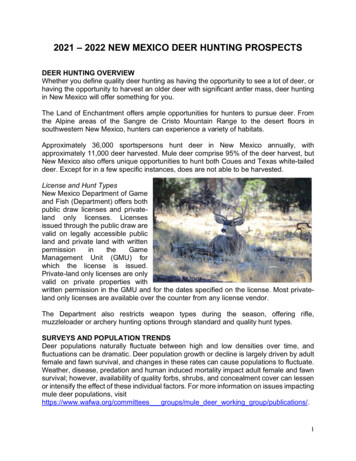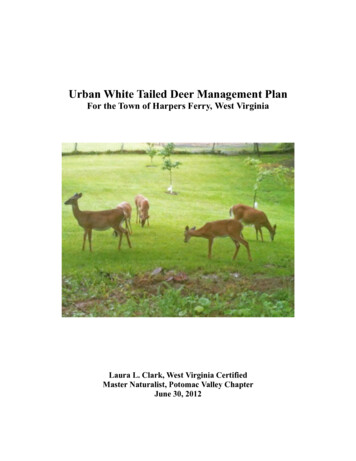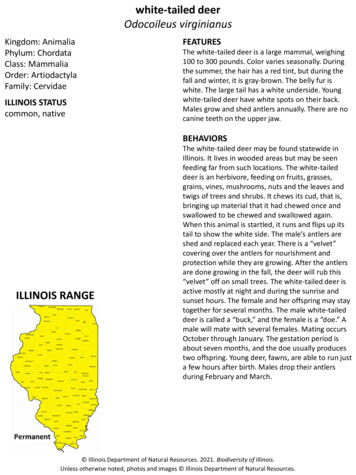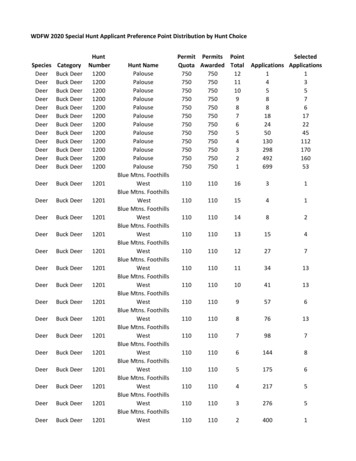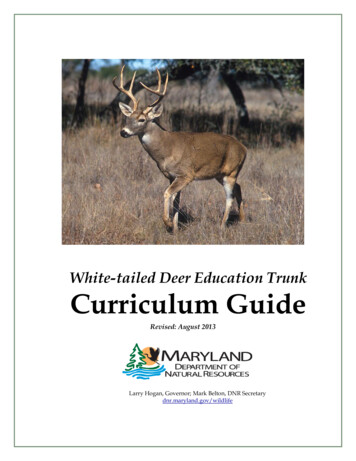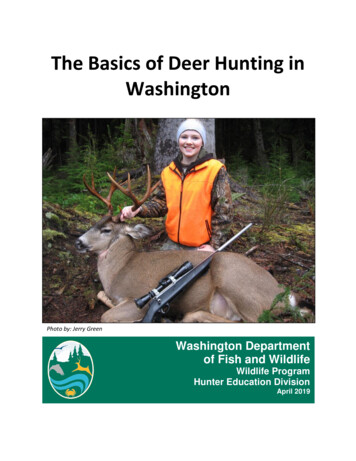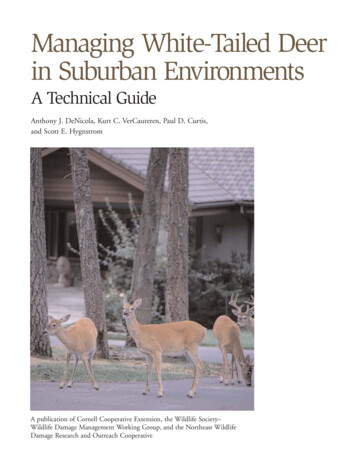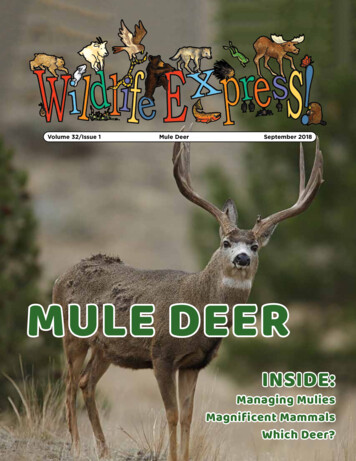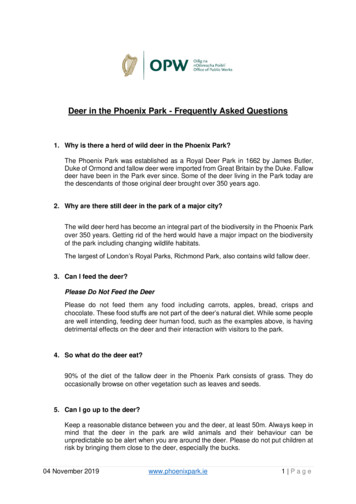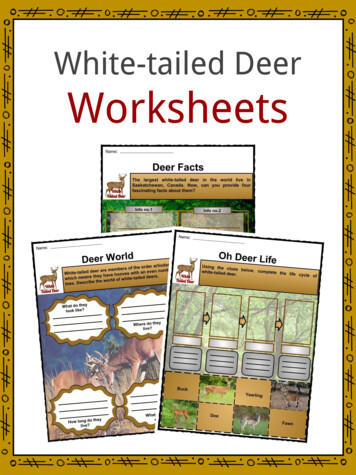
Transcription
White-tailed DeerWorksheets
Free SampleThank you so much for downloading the sample resource.We hope it has been useful for you in the classroom and that yourstudents enjoy the activities.KidsKonnect is a very small family run business and we are proudthat we can offer education to over 40 countries globally. Themore support we have from our Premium members the moreresources we can release.If you want the more comprehensive and detailed worksheetcollection then please upgrade to our Premium plan and supportour quest to make education affordable for all.Don’t forget to come back and download the new material we addevery week!Thanks for supporting KidsKonnect. We can provide teachers withlow-cost, high-quality teaching resources because of our loyalsubscribers and hope to serve you for many years to come.-Ryan, Beth & Nicola :)
White-tailed Deer FactsScientific Name: OdocoileusvirginianusCommon Name: White-tailedDeerThe white-tailed deer is the smallestamong the deer family found in North,Central and South America. Theyhave a white tail when displayedvertically.Type: MammalHabitat, Anatomy and Life Cycle White-tailed deer typically live inGroup Name: Herdfields and meadows near streamsor rivers during summer. They alsoAverage Size: 6 to 7.75 ftinhabit coniferous forests in winter.Average Weight: Among the North American deer110 to 300 lbsfamily, they are the smallest. Theyare native to the United States,Average Lifespan in Captivity:Canada, Mexico, Central America6 to 14 yearsand South America.Diet: Herbivore
White-tailed Deer Facts White-tailed deer are alsointroduced in many countriesincluding New Zealand, PuertoRico, Serbia, Czech Republicand bian white-tailed deerdominate the population.“White-tailed” refers to thewhite underside of the deer’stail usually shown wheneverthey feel danger.Male white-tailed deer arecalledbucksandaredistinguished by their largeantlers during summer and fall.Come winter, the antlers fall offand grow again the next year.Adult buck have reddish-browncoats during the summer heat,which fades to grayish-brownin winter.A female deer is called a doe,while young deer are calledfawns.White-taileddeerareherbivores, meaning they eatwidevarietyofgreensincluding leaves, twigs, nuts,fruit and grass. They have good eyesight, anextreme sense of smell andacute hearing. They can runup to 48 kilometers per hourand leap as high as 10 feet.They are crepuscular animals,making them most active atdusk and dawn. Other thangood sprinters, white-taileddeer are good swimmers.In the northern parts of theirrange, white-tailed deer matein late October until earlyNovember while in thesouthern parts rutting occursin January and February.The gestation period forfemales lasts for 6 ½ months.After this period, they will givebirth to between 1 and 3reddish-brown spotted fawns.
White-tailed Deer Facts At birth, fawns are able towalk. They nurse for 8 weeksuntil vegetation is added totheir diet. After a year, malefawns usually leave whilefemale fawns stay with theirmother until 2 years old.An average doe reach sexualmaturity at the age of 1 ½years but some can also bepregnant at 6 months olddepending on the availability offood.Antlers are used during themating season when malesfight to breed with females.White-taileddeerhavepreorbital, forehead, tarsal,and metatarsal glands, whichallow them to produce scent.OthermembersoftheCervidae family, including elk,moose and mule deer, alsohave antlers. Antlers are boneformations that develop fromthe pedicle on the frontal boneof the skull. Male fawns beginto show buttons for antlers asearly as 4 to 5 months old. In the wild, most white-taileddeer live about 2 to 3 years buttheir maximum lifespan is20 years.Among their natural predatorsare wolves, coyotes, bears,mountain lions, jaguars andhuman hunters.Using the Bergmann’s rule,white-tailed deer are larger insize the farther away from theequator they live.In the Andes, white-tailed deerare larger with thick andslightly woolly looking fur.Although it is unusual for a doeto have antlers, it is possibledue to freemartinism or animbalance in testosterone.Like humans, they havethirty-two teeth.
White-tailed Deer Facts Like cows, they have a four-chamberedstomachenabling them to digest toughplants.At 18 months old, deer losetheir baby teeth and growpermanent ones.Behavioral Traits andConservation Status Bucks partake in sparringsessions to test strength anddominance over the fraternalgroup. It actually prevents realfights that may cause extremeinjuries and death. They alsomark their territory by a buckrub or removing bark from treeswith their antlers.In 2005, there were anestimated 30 million white-taileddeer in the United States aftercommercial exploitation of deerbecame illegal in 1930.Ecologists and hunters supportconservationprogramsforwhite-tailed deer in the U.S. White-tailed deer are ‘flightanimals’ using their speedandagilitytooutrunpredators.They communicate with one another through several typesof vocalization such asgrunts, bleats and wheezes.They usually gather in family Other EnDEERing factsgroups composed of mothers The white-tailed deer is theand fawns. When a doe hasofficial state animal of theno fawns, she lives alone.followingstates:Arkansas,Male deer also live in smallIllinois, Michigan, Mississippi,groups of three to five bucks,Nebraska, New Hampshire,except during mating seasonOhio, Pennsylvania and Southor rut.Carolina.When looking for food, Furthermore, it is the nationalmothers leave their fawns insymbol of Honduras and Costahiding places until they comeRica.back. Over 4 million white-tailed deerare found in the state of Texas.
Name:Deer WorldWhiteTailed DeerWhite-tailed deer are members of the order artiodactyla,which means they have hooves with an even number oftoes. Describe the world of white-tailed deers.What do theylook like?Where do theylive?How long do theylive?What do theyeat?
Deer WorldAnswer keyWhiteTailed DeerWhat do theylook like?They are the smallest of theNorth American deer family.Adults have reddish-browncoats during summer, whichfades to grayish-brownduring winter.Their maximum lifespan isup to 20 years but most inthe wild live for 2 to 3 years.How long do theylive?They inhabit openwoodlands, farms, andforests of North, Central,and South America.Where do theylive?They are herbivores, so theyeat a variety of vegetationincluding leaves, bark, fruit,grass, twigs and shrubs.What do theyeat?
Copyright NoticeThis resource is licensed under the Creative CommonsAttribution-NonCommercial 4.0 International license.You are free to: Share — copy and redistribute the material in any medium orformatAdapt — remix, transform, and build upon the materialUnder the following terms: Attribution — You must give appropriate credit, provide a link tothe license, and indicate if changes were made. You may do so inany reasonable manner, but not in any way that suggests thelicensor endorses you or your use.NonCommercial — You may not use the material for commercialpurposes.For more information on this license, visit the following /Thank you!
White-tailed Deer Facts Scientific Name: Odocoileus virginianus Common Name: White-tailed Deer Type: Mammal Diet: Herbivore Group Name: Herd Average Size: 6 to 7.75 ft Average Weight: 110 to 300 lbs Average Lifespan in Captivity: 6 to 14 years The white-tailed deer is the smallest among the deer family found in North, Central and South America .
